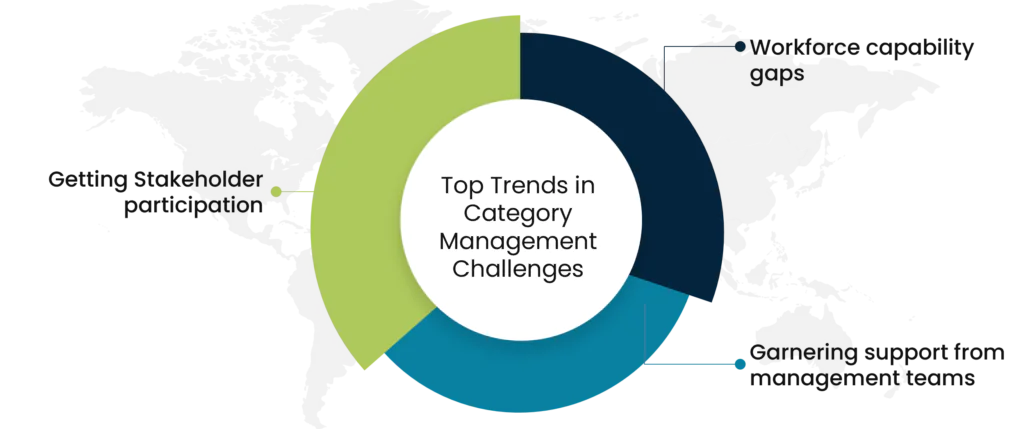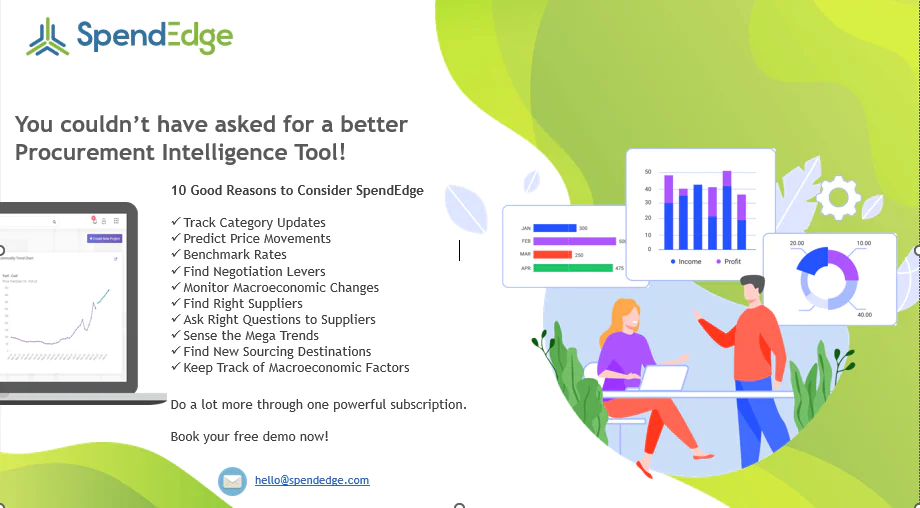Key takeaways
- Strategic Adoption Across Industries: Category management, originating from retail, has become a strategic approach adopted across diverse sectors, offering enhanced management efficiency.
- Challenges in Implementation: Despite its benefits, implementing category management presents challenges, particularly in areas such as inventory management, cost optimization, and risk mitigation.
- Critical Focus Areas: Successful execution hinges on aligning supplier relationships, operational systems, and robust risk mitigation strategies to address supply disruptions, contractual disputes, and quality issues.
- Expert Support for Success: Businesses can navigate these challenges effectively by leveraging specialized expertise, like that offered by SpendEdge, to tailor category management solutions and drive supply chain resilience and innovation.
What is category management?
Category management originated from the retail industry. This retailing and supply management concept involves breaking down the products purchased or sold by a retailer into discrete groups of similar or related products. Category management is a systematic approach to managing a set of products as a strategic business unit.
Category management: In detail
Category management, a strategy widely employed in both public and private sectors, extends beyond its origins in retail. It involves grouping products or services with similar characteristics and shared supply markets for streamlined management. Despite its known benefits, challenges arise during implementation.
One significant challenge lies in inventory management processes, where businesses must align inventory management workflows with category management principles. Additionally, ensuring cost optimization and effective risk management within procurement processes poses hurdles. Maintaining strong supplier relationships amidst evolving operational systems is crucial for successful execution.
Another obstacle involves risk mitigation, particularly in navigating supply disruptions and resolving contractual disputes. Fluctuations in price and addressing quality issues require agile responses to prevent non-compliance. Effective risk assessment and continuous performance monitoring are vital for sustainable improvement in quality and overall procurement effectiveness.
Top Trends in Category Management Challenges

Getting Stakeholder participation
In several procurement organizations, the stakeholders are either unknown or they are not in close contact with the management. It is critical to ensure that the stakeholders understand the importance of category management, which means that they have to put in some work as well. This transforms the stakeholders into active participants and will improve the results for the procurement organization. Without the support of your stakeholders, the results of the new way of working will be disappointing.
Workforce capability gaps
The transformation of an operational department to a more strategic department results in a chance for gaps in the workforce capabilities. This could be because the organization lacks the skills and capability to become the advisor of the business. This situation can overcome by providing specific training and coaching on the skills and capabilities that are needed to the company’s workforce. Furthermore, they can also be provided with coaching-on-the-job, where experts coach the buyers in the new way of working. For capabilities to be enhanced, a budget needs to be made for supporting the training costs for buyers.
Garnering support from management teams
The need for change often comes from the management team of a company. However, during the course of transformation, the same team may display a lack of engagement and operational support. This leads to a transformation that does not fully realize the benefits out of the category management. In order to gain the maximum benefit from category management, there needs to be full support from the management team throughout the transformation. The management team should be available to support with data analysis, value-chain/TCO-analysis, stakeholder meetings, and supplier negotiations.
Some category management solutions businesses must implement to ensure efficiency
Stakeholders alignment and ensuring their participation
Alignment of objectives, interests and expectations between stakeholders is one of the main challenges for category management in terms of getting them to participate. It can be difficult for each stakeholder to make them active participants in the category management process, given their various priorities and objectives. In order to overcome this challenge, it is necessary to ensure transparent and effective communication between all stakeholders so that they understand the importance of category management, know their respective needs as well as balance trade risks.
Bridging Workforce Capability gaps: A solution to enhance workflow
The focus of procurement and inventory management workflows is shifted from operational to strategic with the implementation of category management. This may cause gaps in the current workforce’s capabilities. This obstacle can be addressed by the company’s personnel through on-the-job training or specialised coaching and training programmes, where professionals can mentor staff members on the new methods of operation. A budget must be set aside to cover the costs of training and close the capabilities gap.
Support from management teams
Even though management teams are frequently the first to suggest changes, when it comes to the real transformation, they frequently lack operational support and involvement. Consequently, enterprises might not be able to fully achieve category management’s potential. Category management can be successfully implemented by involving the management teams at every stage of the transformation process, from data analysis to supplier negotiations and stakeholder meetings.
Managing change
Implementing category management is a big difficulty in terms of change management, just like any other transition. Organisational culture, operational systems, and procurement procedures may all need to alter as a result of category management. It’s possible that certain stakeholders will fight these changes and be hesitant to accept them. The strategy to solve this category management difficulty is to show stakeholders the benefits of category management, involve them in the transformation process, and listen to their concerns and suggestions at every stage of the process.
Risk mitigation
Category management can also be severely hampered by risk management and mitigation, since these activities may expose the business to a range of hazards, such as non-compliance, price fluctuations, contractual conflicts, disruptions in the supply chain, and quality problems. You may solve this difficulty by carrying out a comprehensive risk assessment, creating risk management and backup plans, continuously tracking performance, and putting the required corrective steps into place. You can guarantee that sufficient governance, controls, and audit procedures are in place to guarantee risk minimization, accountability, and compliance by using a category management plan.
The SpendEdge Advantage
Businesses can greatly benefit from adopting category management as one of its best practices in procurement. SpendEdge’s category management solutions have the capacity to add value in reducing supply chain risk as well as drive innovation in different supply chain categories. Our category management experts have proven expertise in helping organizations tap into opportunities in order to manage demand, have better cash flow management, and enforce greater compliance of standards from suppliers. Get in touch with us for tailor-made solutions to suit your business.

Conclusion
Category management, originating from the retail sector, is a strategic approach now widely adopted across industries, including public and private sectors. . However, challenges abound in its implementation, particularly concerning inventory management processes, cost optimization, and risk management within procurement processes. Successful execution requires alignment of supplier relationships, operational systems, and diligent risk mitigation strategies to address potential hurdles such as supply disruptions, contractual disputes, and price fluctuations. Moreover, vigilance against quality issues and non-compliance is essential, necessitating continuous risk assessment and performance monitoring for sustained quality improvement. Businesses can leverage the expertise of organizations like SpendEdge to navigate these challenges effectively, utilizing tailored category management solutions to enhance supply chain resilience, drive innovation, and ensure compliance with industry standards.





